Anti-Snoring Devices Market Size
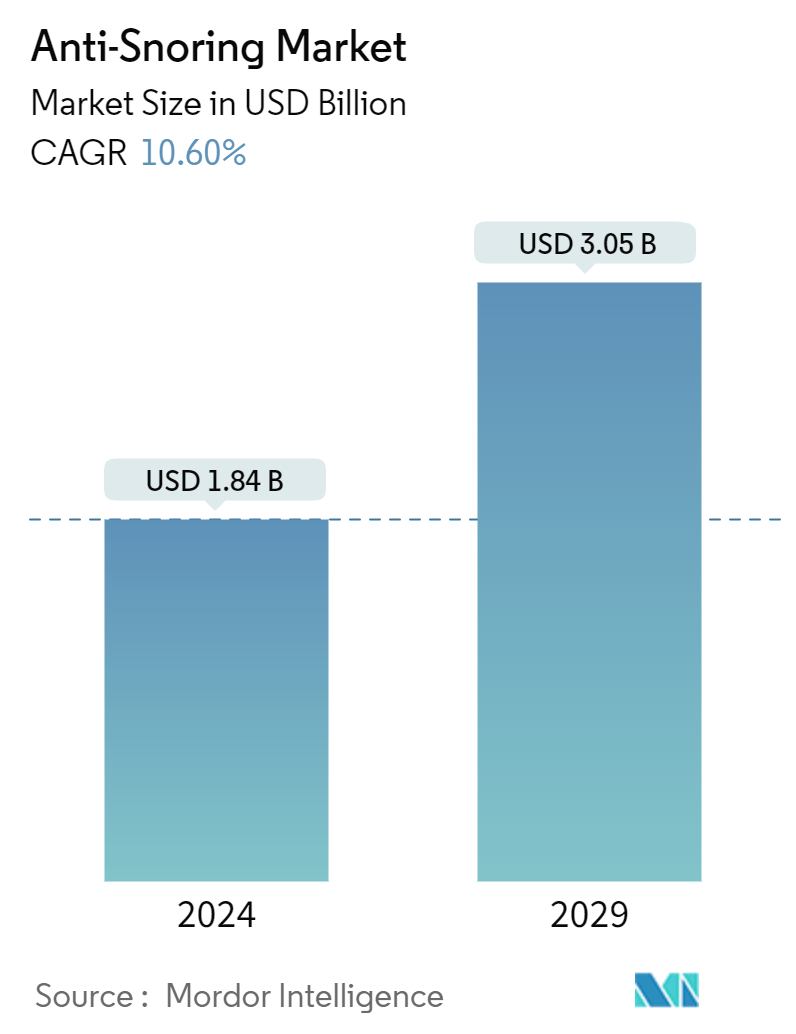
| Study Period | 2019 - 2029 |
| Market Size (2024) | USD 1.84 Billion |
| Market Size (2029) | USD 3.05 Billion |
| CAGR (2024 - 2029) | 10.60 % |
| Fastest Growing Market | Asia Pacific |
| Largest Market | North America |
| Market Concentration | Low |
Major Players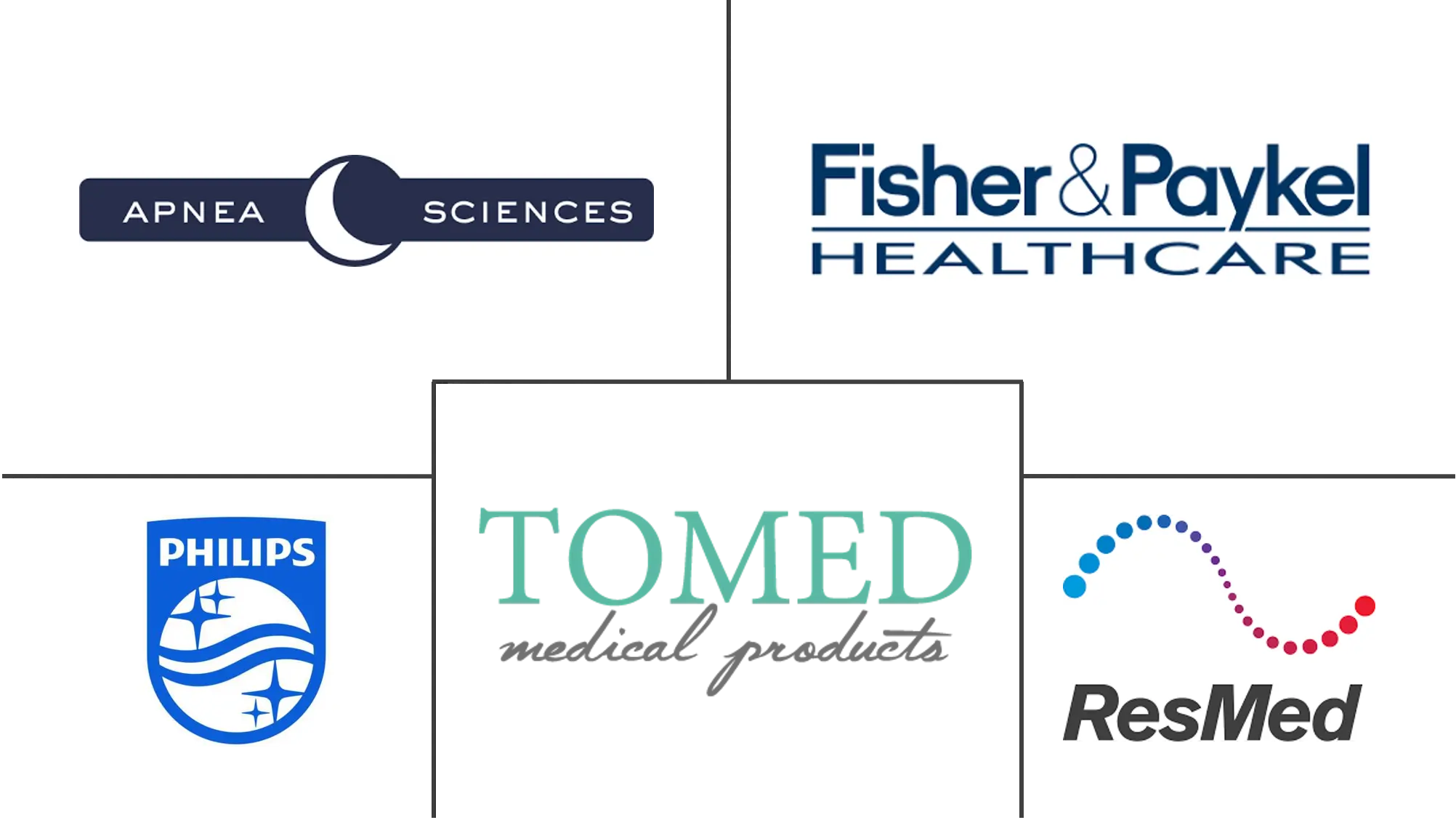
*Disclaimer: Major Players sorted in no particular order |
Anti-Snoring Devices Market Analysis
The Anti-Snoring Market size is estimated at USD 1.84 billion in 2024, and is expected to reach USD 3.05 billion by 2029, growing at a CAGR of 10.60% during the forecast period (2024-2029).
An increase in the obese and geriatric population, increasing smoking and alcohol consumption, technological advancements in anti-snoring devices, and increased awareness among the people are the key factors responsible for the growth of the market.
Obesity, driven by sedentary lifestyles and poor dietary choices, is a primary catalyst for market expansion. For instance, the 2024 World Obesity Atlas report forecasts that around 79% of adults identified as overweight or obese will be in low-to-middle-income countries by 2035. The global count of obese adults, at 0.81 billion in 2020, is set to double to 1.53 billion by 2035. Additionally, the report highlights that 88% of children categorized as overweight or obese will likely be in low-to-middle-income nations by 2035. This rising obesity rate is leading to more snoring incidents, as fat accumulation in the neck can obstruct the upper airway during sleep, boosting the demand for snoring devices.
Tonsillectomy, a surgical procedure, is known to alleviate snoring, especially in children, often within a month post-surgery. For instance, an August 2022 update from Statpearls highlighted that tonsillectomy ranks among the most frequently conducted surgeries in the United States, with over 500,000 annual cases in children under 15. Sleep-disordered breathing (SDB) is a primary reason for these tonsillectomies. Given this, the high volume of tonsillectomy procedures is likely to drive demand for anti-snoring solutions, like tongue-retaining devices, bolstering market growth.
Technological innovations and product launches by key players are set to further fuel market expansion. For instance, in January 2023, Vivos Therapeutics Inc. secured Food and Drug Administration (FDA) clearance for its DNA appliance, targeting mild-to-moderate obstructive sleep apnea (OSA) and snoring.
Similarly, ProSomnus got FDA 510(k) clearance in November 2022 for its ProSomnus EVO [PH] device. This precision oral appliance therapy (OAT) aims to mitigate nighttime snoring and mild to moderate OSA in adults by stabilizing the jaw during sleep, enhancing pharyngeal space, and minimizing upper airway collapse risks.
Given the rising obesity rates, sleep disorders, and frequent product approvals, the market is poised for growth. Yet, challenges like the steep price of custom oral devices and societal stigma surrounding snoring could temper this expansion.
Anti-Snoring Devices Market Trends
The Mandibular Advancement Devices (MAD) Sub-segment is Expected to Hold a Significant Market Share During the Forecast Period
Mandibular advancement devices (MAD) are pivotal in the anti-snoring device market, owing to their proven effectiveness and non-invasive approach. These devices aim to mitigate snoring and address mild to moderate obstructive sleep apnea by shifting the lower jaw forward during sleep.
Moreover, increasing investments in sleep research, a surge in product approvals and launches, and innovative developments by global key players are propelling the growth of this segment in the market.
Numerous studies underscore the effectiveness of MADs in curbing snoring, forecasting a rise in their adoption. For instance, at SLEEP 2024 in Houston, a recent study introduced a validated technology for tracking mandibular jaw movements. This technology established a clear link between the protrusion levels of MADs and sleep duration. The study also highlighted a 10.6% reduction in snoring symptoms. Given these insights, a heightened demand for anti-snoring solutions is anticipated, signaling robust growth for this segment.
Additionally, key players' product launches are set to bolster segment growth. For instance, Glidewell unveiled the Silent Nite Sleep Appliance, an extension of its Silent Nite brand, in July 2022. This new MAD targets both snoring and obstructive sleep apnea (OSA).
In conclusion, ongoing research and product innovations are poised to fuel the growth of this sub-segment in the coming years.
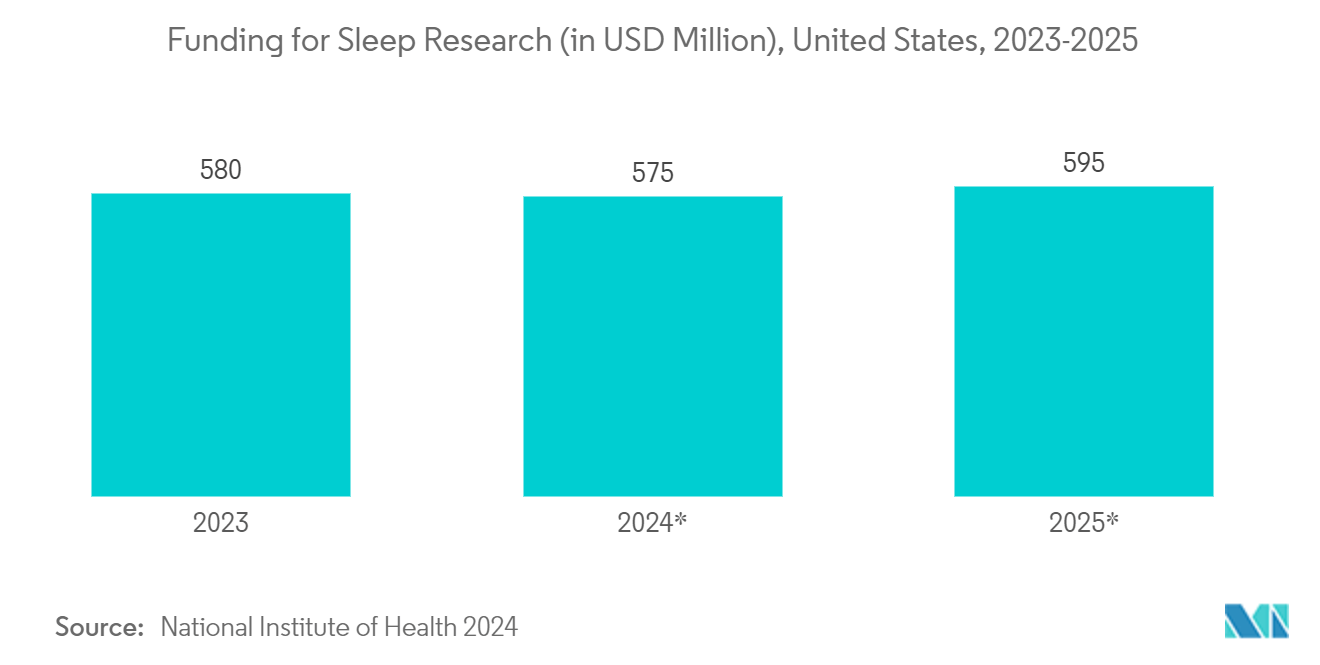
North America is Expected to Hold a Significant Share in the Market During the Forecast Period
North America is poised to witness a substantial market share, driven by a confluence of factors: a pronounced incidence of sleep disorders, robust spending on research and development (R&D), a flurry of product launches and approvals, and a dense concentration of market players.
Snoring frequently signals the presence of obstructive sleep apnea (OSA), a prevalent sleep disorder. Given the widespread prevalence of sleep disorders, there's a surging demand for anti-snoring devices, fueling market expansion. For instance, data from the Sleep and Sleep Disorders statistics, updated in November 2022, highlighted that about 34% of females and 35.8% of males in the United States experienced short sleep durations in 2022. This pronounced prevalence of sleep apnea, often arising from snoring, is set to escalate the demand for anti-snoring devices, propelling market growth in the region.
Moreover, individuals with excess weight are more prone to snoring, primarily due to additional soft tissue in the mouth and throat. Given the region's obesity challenges, there's a heightened incidence of snoring, suggesting robust market growth in the coming years. For context, the Obesity Atlas 2024 report noted that in 2022, 31.28 million children in the United States had a high body mass index (BMI), with projections reaching 35.25 million by 2035. This rising obesity trend amplifies the risk of snoring, hinting at a surge in anti-snoring device usage and, consequently, market growth.
Additionally, as per the May 2022 update from the National Institute of Health's Estimates of Funding for Various Research, Condition, and Disease Categories (RCDC), United States spending on sleep research R&D was USD 580 million in 2023, with a slight dip to an anticipated USD 575 million in 2024. Such government backing in sleep research not only underscores its importance but also paves the way for market players to innovate and develop advanced devices for snoring management, further fueling market growth.
Moreover, the region's rising product approvals and launches contribute significantly to market growth. For instance, in November 2023, Vivos Therapeutics, Inc. received 510(k) clearance from the United States Food and Drug Administration for the Vivos’ removable CARE (Complete Airway Repositioning and Expansion) oral appliances. This appliance is a non-invasive treatment for snoring and sleep apnea.
In conclusion, the North American market is set for growth, bolstered by the region's challenges with sleep disorders and obesity, escalating R&D investments, and a steady stream of product innovations and approvals.
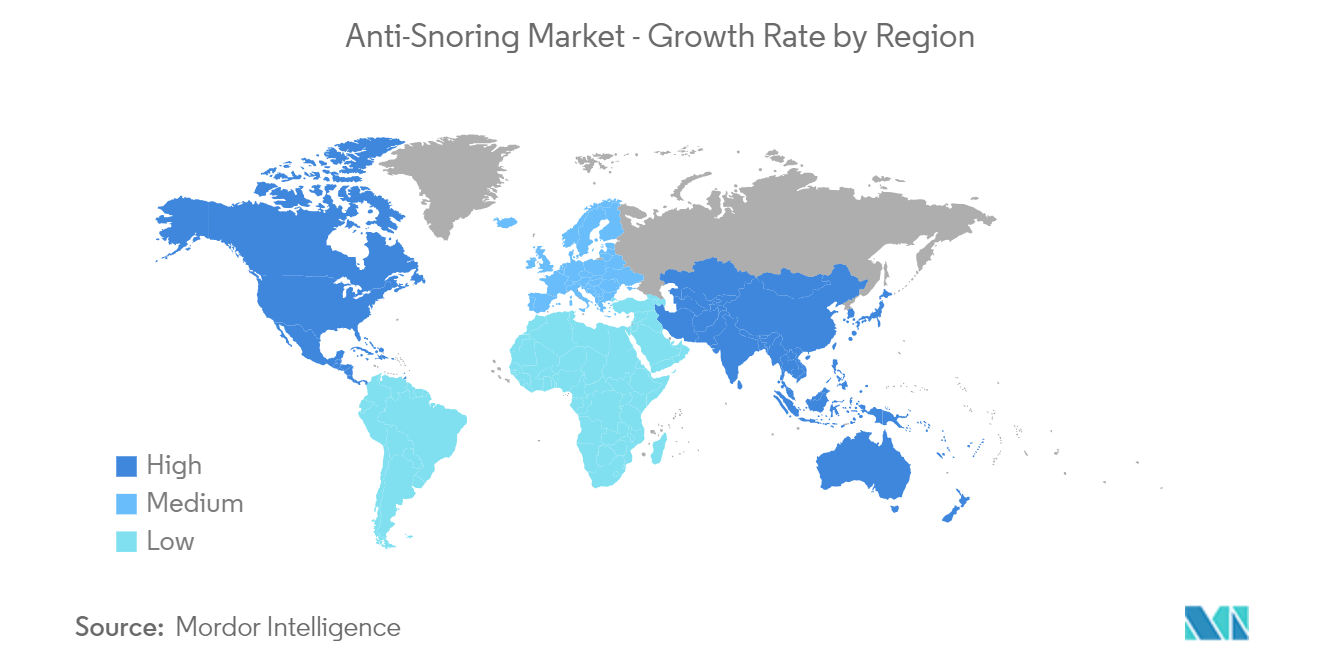
Anti-Snoring Devices Industry Overview
The anti-snoring market features a fragmented landscape, dominated by several key players. The competitive landscape includes an analysis of a few international and local companies that hold major or significant market shares. These players are not only innovating by developing new anti-snoring devices but are also expanding their portfolios across multiple countries. Some of the key players include Fisher & Paykel Healthcare Limited, Koninklijke Philips NV, ResMed, ASF Medical GmbH (Tomed GmbH), and Apnea Sciences.
Anti-Snoring Devices Market Leaders
-
Fisher & Paykel Healthcare Limited
-
Koninklijke Philips NV
-
Resmed
-
ASF Medical GmbH (Tomed GmbH)
-
Apnea Sciences
*Disclaimer: Major Players sorted in no particular order
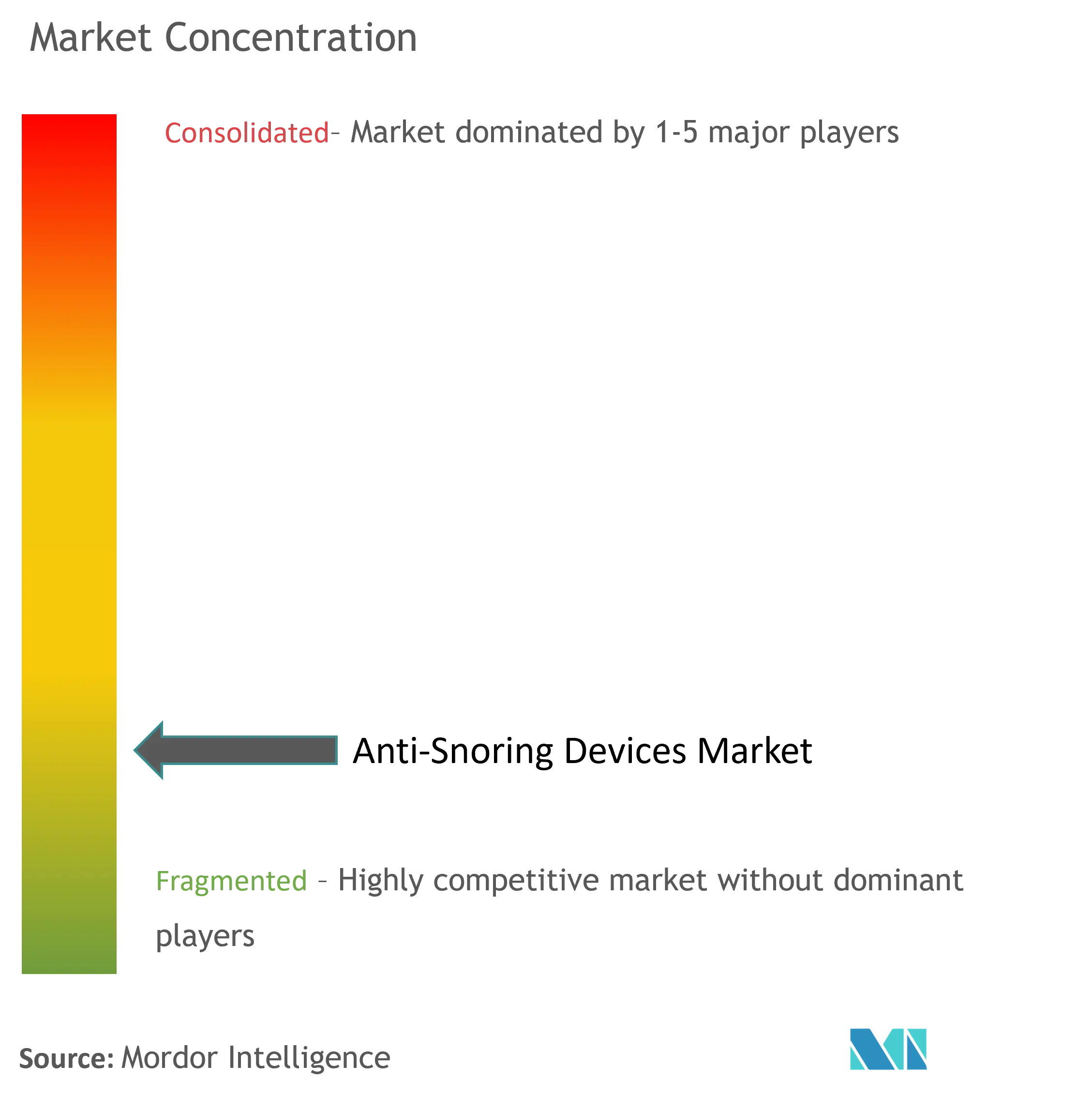
Anti-Snoring Devices Market News
- May 2024: Glidewell introduced the Silent Nite 3D Sleep Appliance, a state-of-the-art, 3D-printed solution tailored for dental professionals. This groundbreaking appliance is aimed at individuals suffering from snoring and those with mild to moderate obstructive sleep apnea (OSA).
- January 2024: Maryland-based SnoreLessNow obtained FDA approval for its Anti-snore Mouth Guard+. This over-the-counter solution for snoring is a joint venture between SnoreLessNow and Oscimed SA, a Swiss manufacturer.
Anti-Snoring Market Report - Table of Contents
1. INTRODUCTION
1.1 Study Assumptions and Market Definition
1.2 Scope of the Study
2. RESEARCH METHODOLOGY
3. EXECUTIVE SUMMARY
4. MARKET DYNAMICS
4.1 Market Overview
4.2 Market Drivers
4.2.1 Increase in Obesity and Geriatric Population
4.2.2 Increasing Smoking and Alcohol Consumption
4.2.3 Technological Advancements in Anti-Snoring Devices
4.3 Market Restraints
4.3.1 High Costs of Custom-made Oral Devices
4.3.2 Poor Efficacy and Lack of Scientific Validation of the Anti-snoring Devices
4.3.3 Social Stigma Associated with Snoring
4.4 Porter's Five Forces Analysis
4.4.1 Threat of New Entrants
4.4.2 Bargaining Power of Buyers/Consumers
4.4.3 Bargaining Power of Suppliers
4.4.4 Threat of Substitute Products
4.4.5 Intensity of Competitive Rivalry
5. MARKET SEGMENTATION (Market Size by Value - USD)
5.1 By Device Type
5.1.1 Mandibular Advancement Devices (MAD)
5.1.2 Tongue Stabilizing Devices (TSD)
5.1.3 Continuous Positive Airway Pressure (CPAP) Devices
5.1.4 Other Device Types
5.2 By Surgical Procedure
5.2.1 Uvulopalatopharyngoplasty (UPPP)
5.2.2 Somnoplasty
5.2.3 Pillar Procedure
5.2.4 Tonsillectomy
5.2.5 Radiofrequency Palatoplasty
5.2.6 Other Surgical Procedures
5.3 Geography
5.3.1 North America
5.3.1.1 United States
5.3.1.2 Canada
5.3.1.3 Mexico
5.3.2 Europe
5.3.2.1 Germany
5.3.2.2 United Kingdom
5.3.2.3 France
5.3.2.4 Italy
5.3.2.5 Spain
5.3.2.6 Rest of Europe
5.3.3 Asia-Pacific
5.3.3.1 China
5.3.3.2 Japan
5.3.3.3 India
5.3.3.4 Australia
5.3.3.5 South Korea
5.3.3.6 Rest of Asia-Pacific
5.3.4 Middle East and Africa
5.3.4.1 GCC
5.3.4.2 South Africa
5.3.4.3 Rest of Middle East and Africa
5.3.5 South America
5.3.5.1 Brazil
5.3.5.2 Argentina
5.3.5.3 Rest of South America
6. COMPETITIVE LANDSCAPE
6.1 Company Profiles
6.1.1 Apnea Sciences
6.1.2 ASF Medical GmbH (Tomed GmbH)
6.1.3 Fisher & Paykel Healthcare Limited
6.1.4 Koninklijke Philips N.V
6.1.5 Lear Corporation (AccuMED Corp.)
6.1.6 Meditas
6.1.7 Mitsui Chemicals (Whole You Inc.)
6.1.8 ResMed
6.1.9 SomnoMed
6.1.10 The Pure Sleep Company
6.1.11 Innovative Health Technologies
6.1.12 GSK Plc
6.1.13 Rotech Healthcare
- *List Not Exhaustive
7. MARKET OPPORTUNITIES AND FUTURE TRENDS
Anti-Snoring Devices Industry Segmentation
Anti-snoring treatment devices are tools designed to curb snoring. Typically, these devices come in two pieces, fitting over the upper and lower teeth. By shifting the lower jaw forward, they expand the airway, facilitating easier breathing, diminishing snoring, and mitigating the risks and severity of obstructive sleep apnea.
The anti-snoring treatment market is segmented by device type, surgical procedure, and geography. By device type, the market is segmented into mandibular advancement devices (MAD), tongue stabilizing devices (TSD), continuous positive airway pressure (CPAP) devices, and other device types. By surgical procedure, the market is segmented into uvulopalatopharyngoplasty (UPPP), somnoplasty, pillar procedure, tonsillectomy, radiofrequency palatoplasty, and other surgical procedures. By geography, the market is divided into North America, Europe, Asia-Pacific, and Rest of the World. The report offers the value (in USD) for the above segments.
| By Device Type | |
| Mandibular Advancement Devices (MAD) | |
| Tongue Stabilizing Devices (TSD) | |
| Continuous Positive Airway Pressure (CPAP) Devices | |
| Other Device Types |
| By Surgical Procedure | |
| Uvulopalatopharyngoplasty (UPPP) | |
| Somnoplasty | |
| Pillar Procedure | |
| Tonsillectomy | |
| Radiofrequency Palatoplasty | |
| Other Surgical Procedures |
| Geography | ||||||||
| ||||||||
| ||||||||
| ||||||||
| ||||||||
|
Anti-Snoring Market Research Faqs
How big is the Anti-Snoring Market?
The Anti-Snoring Market size is expected to reach USD 1.84 billion in 2024 and grow at a CAGR of 10.60% to reach USD 3.05 billion by 2029.
What is the current Anti-Snoring Market size?
In 2024, the Anti-Snoring Market size is expected to reach USD 1.84 billion.
Who are the key players in Anti-Snoring Market?
Fisher & Paykel Healthcare Limited, Koninklijke Philips NV, Resmed, ASF Medical GmbH (Tomed GmbH) and Apnea Sciences are the major companies operating in the Anti-Snoring Market.
Which is the fastest growing region in Anti-Snoring Market?
Asia Pacific is estimated to grow at the highest CAGR over the forecast period (2024-2029).
Which region has the biggest share in Anti-Snoring Market?
In 2024, the North America accounts for the largest market share in Anti-Snoring Market.
What years does this Anti-Snoring Market cover, and what was the market size in 2023?
In 2023, the Anti-Snoring Market size was estimated at USD 1.64 billion. The report covers the Anti-Snoring Market historical market size for years: 2019, 2020, 2021, 2022 and 2023. The report also forecasts the Anti-Snoring Market size for years: 2024, 2025, 2026, 2027, 2028 and 2029.
Anti-Snoring Industry Report
Statistics for the 2024 Cyber Security Software market share, size and revenue growth rate, created by Mordor Intelligence™ Industry Reports. Cyber Security Software analysis includes a market forecast outlook 2029 and historical overview. Get a sample of this industry analysis as a free report PDF download.



